Report on Business Communication Principles: Negotiation & More
VerifiedAdded on 2023/03/21
|10
|2809
|69
Report
AI Summary
This report provides a comprehensive overview of key principles in business communication, covering negotiation tactics, presentation methods, bespoke document creation, and information systems. It highlights the importance of negotiation in building business relationships and achieving lasting solutions, explores different approaches to negotiation, and outlines essential components of negotiation tactics. The report also details various types of presentations, resources for effective presentations, delivery methods, and best practices, including collecting and utilizing feedback. Furthermore, it discusses the characteristics of bespoke documents, legal requirements for gathering information, techniques for creation, and approval processes. Finally, the report examines the stages of information system development, benefits and limitations of different systems, legal and security requirements, and methods for monitoring system use and effectiveness. Desklib provides access to this and many other solved assignments for students.
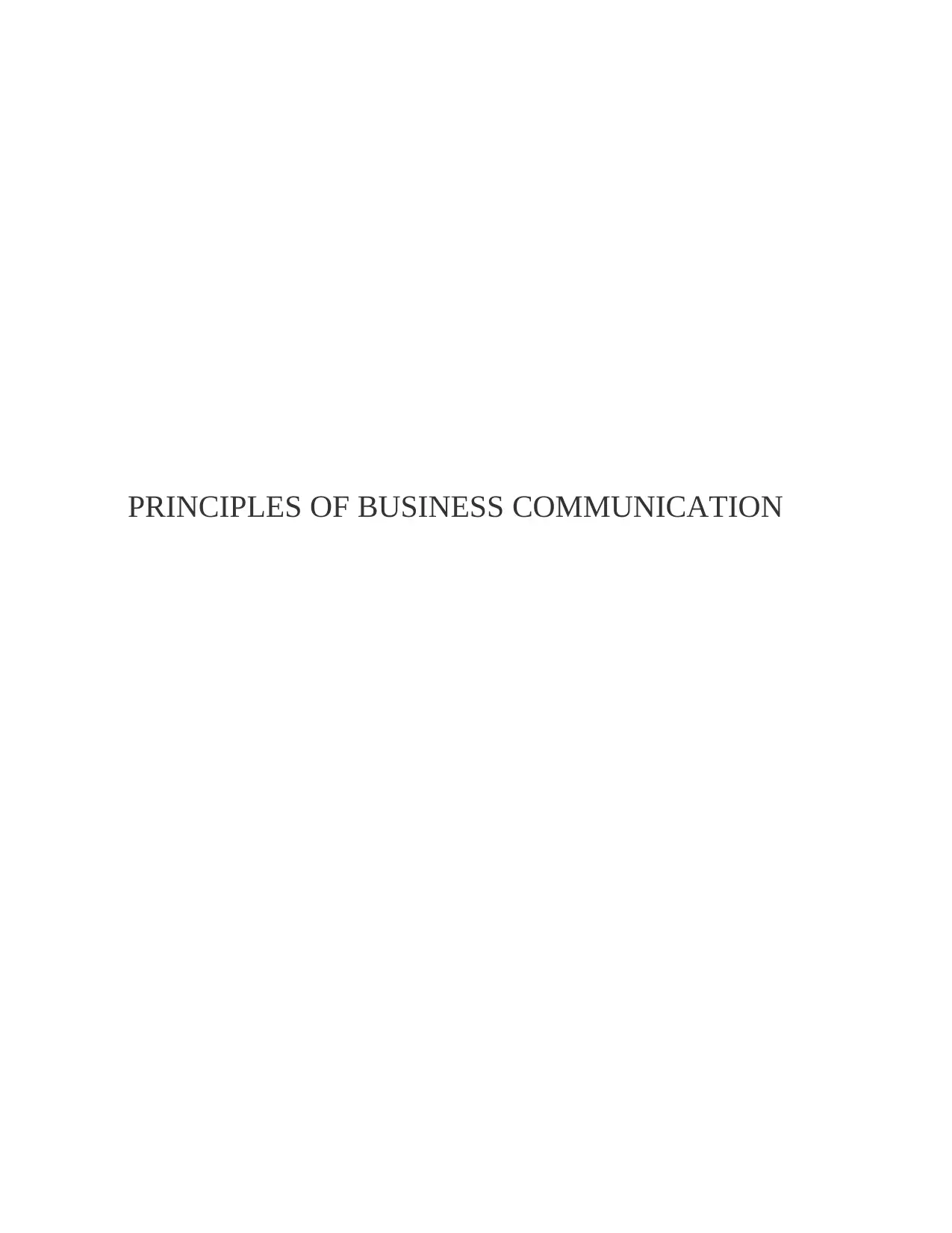
PRINCIPLES OF BUSINESS COMMUNICATION
Paraphrase This Document
Need a fresh take? Get an instant paraphrase of this document with our AI Paraphraser
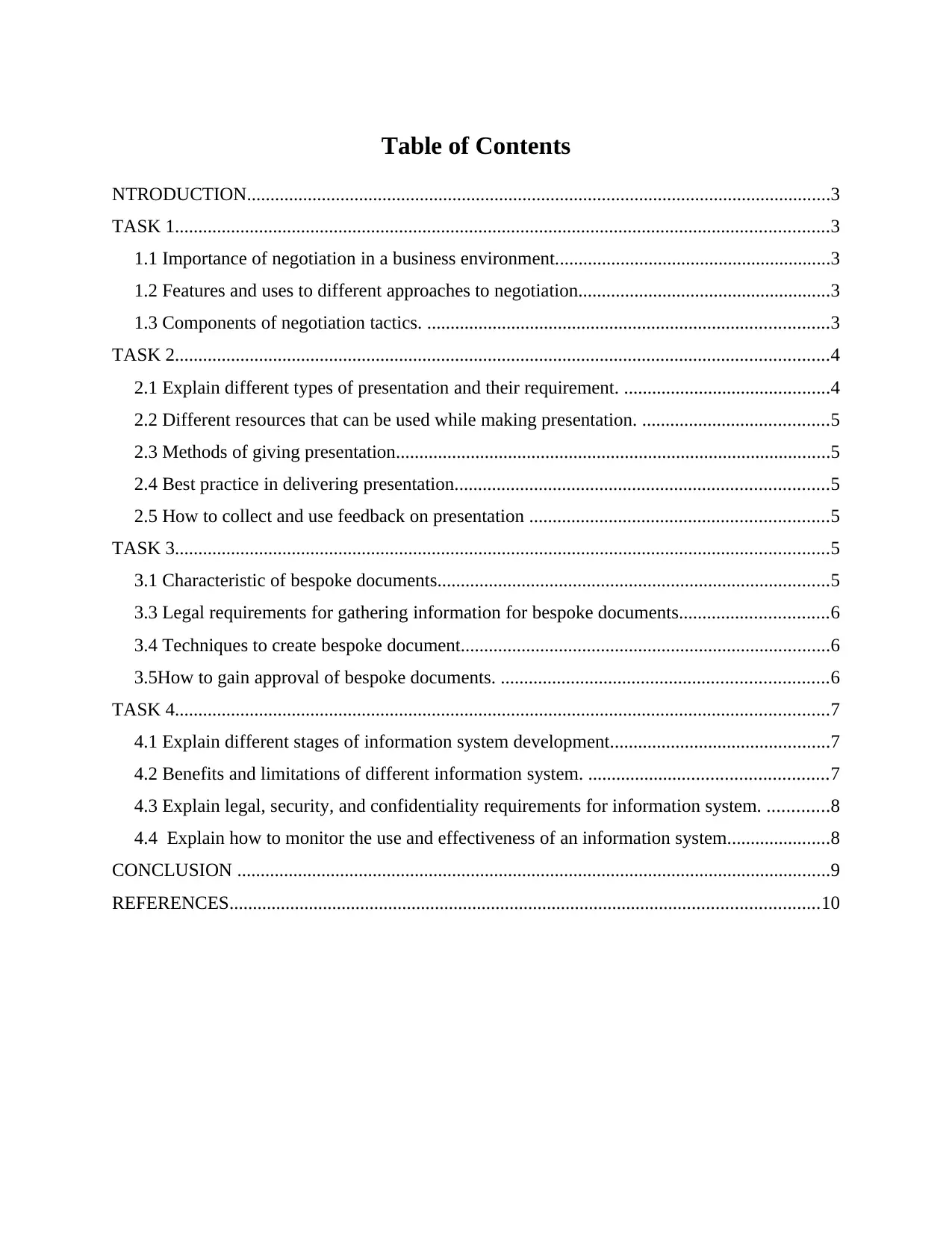
Table of Contents
NTRODUCTION.............................................................................................................................3
TASK 1............................................................................................................................................3
1.1 Importance of negotiation in a business environment...........................................................3
1.2 Features and uses to different approaches to negotiation......................................................3
1.3 Components of negotiation tactics. ......................................................................................3
TASK 2............................................................................................................................................4
2.1 Explain different types of presentation and their requirement. ............................................4
2.2 Different resources that can be used while making presentation. ........................................5
2.3 Methods of giving presentation.............................................................................................5
2.4 Best practice in delivering presentation................................................................................5
2.5 How to collect and use feedback on presentation ................................................................5
TASK 3............................................................................................................................................5
3.1 Characteristic of bespoke documents....................................................................................5
3.3 Legal requirements for gathering information for bespoke documents................................6
3.4 Techniques to create bespoke document...............................................................................6
3.5How to gain approval of bespoke documents. ......................................................................6
TASK 4............................................................................................................................................7
4.1 Explain different stages of information system development...............................................7
4.2 Benefits and limitations of different information system. ...................................................7
4.3 Explain legal, security, and confidentiality requirements for information system. .............8
4.4 Explain how to monitor the use and effectiveness of an information system......................8
CONCLUSION ...............................................................................................................................9
REFERENCES..............................................................................................................................10
NTRODUCTION.............................................................................................................................3
TASK 1............................................................................................................................................3
1.1 Importance of negotiation in a business environment...........................................................3
1.2 Features and uses to different approaches to negotiation......................................................3
1.3 Components of negotiation tactics. ......................................................................................3
TASK 2............................................................................................................................................4
2.1 Explain different types of presentation and their requirement. ............................................4
2.2 Different resources that can be used while making presentation. ........................................5
2.3 Methods of giving presentation.............................................................................................5
2.4 Best practice in delivering presentation................................................................................5
2.5 How to collect and use feedback on presentation ................................................................5
TASK 3............................................................................................................................................5
3.1 Characteristic of bespoke documents....................................................................................5
3.3 Legal requirements for gathering information for bespoke documents................................6
3.4 Techniques to create bespoke document...............................................................................6
3.5How to gain approval of bespoke documents. ......................................................................6
TASK 4............................................................................................................................................7
4.1 Explain different stages of information system development...............................................7
4.2 Benefits and limitations of different information system. ...................................................7
4.3 Explain legal, security, and confidentiality requirements for information system. .............8
4.4 Explain how to monitor the use and effectiveness of an information system......................8
CONCLUSION ...............................................................................................................................9
REFERENCES..............................................................................................................................10
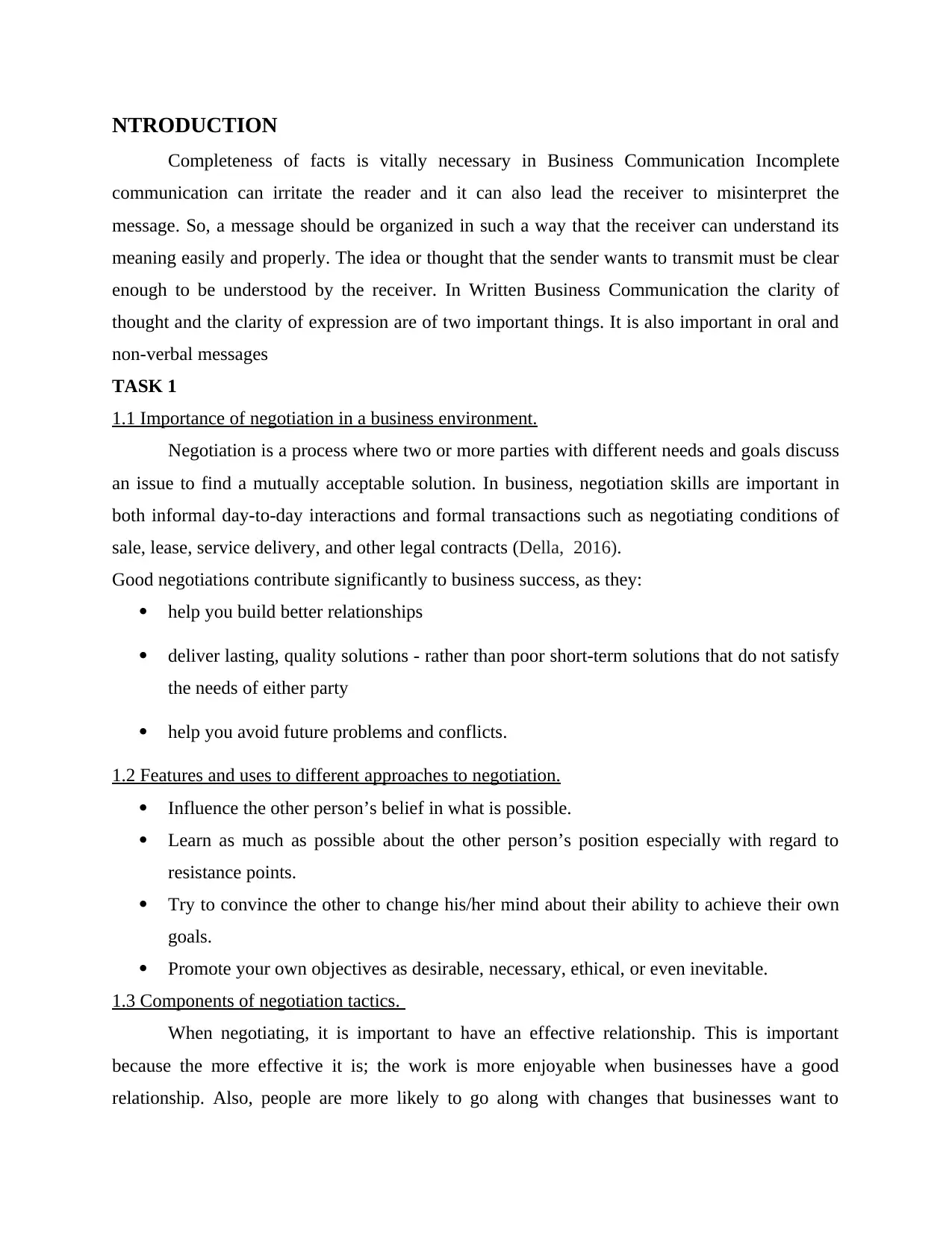
NTRODUCTION
Completeness of facts is vitally necessary in Business Communication Incomplete
communication can irritate the reader and it can also lead the receiver to misinterpret the
message. So, a message should be organized in such a way that the receiver can understand its
meaning easily and properly. The idea or thought that the sender wants to transmit must be clear
enough to be understood by the receiver. In Written Business Communication the clarity of
thought and the clarity of expression are of two important things. It is also important in oral and
non-verbal messages
TASK 1
1.1 Importance of negotiation in a business environment.
Negotiation is a process where two or more parties with different needs and goals discuss
an issue to find a mutually acceptable solution. In business, negotiation skills are important in
both informal day-to-day interactions and formal transactions such as negotiating conditions of
sale, lease, service delivery, and other legal contracts (Della, 2016).
Good negotiations contribute significantly to business success, as they:
help you build better relationships
deliver lasting, quality solutions - rather than poor short-term solutions that do not satisfy
the needs of either party
help you avoid future problems and conflicts.
1.2 Features and uses to different approaches to negotiation.
Influence the other person’s belief in what is possible.
Learn as much as possible about the other person’s position especially with regard to
resistance points.
Try to convince the other to change his/her mind about their ability to achieve their own
goals.
Promote your own objectives as desirable, necessary, ethical, or even inevitable.
1.3 Components of negotiation tactics.
When negotiating, it is important to have an effective relationship. This is important
because the more effective it is; the work is more enjoyable when businesses have a good
relationship. Also, people are more likely to go along with changes that businesses want to
Completeness of facts is vitally necessary in Business Communication Incomplete
communication can irritate the reader and it can also lead the receiver to misinterpret the
message. So, a message should be organized in such a way that the receiver can understand its
meaning easily and properly. The idea or thought that the sender wants to transmit must be clear
enough to be understood by the receiver. In Written Business Communication the clarity of
thought and the clarity of expression are of two important things. It is also important in oral and
non-verbal messages
TASK 1
1.1 Importance of negotiation in a business environment.
Negotiation is a process where two or more parties with different needs and goals discuss
an issue to find a mutually acceptable solution. In business, negotiation skills are important in
both informal day-to-day interactions and formal transactions such as negotiating conditions of
sale, lease, service delivery, and other legal contracts (Della, 2016).
Good negotiations contribute significantly to business success, as they:
help you build better relationships
deliver lasting, quality solutions - rather than poor short-term solutions that do not satisfy
the needs of either party
help you avoid future problems and conflicts.
1.2 Features and uses to different approaches to negotiation.
Influence the other person’s belief in what is possible.
Learn as much as possible about the other person’s position especially with regard to
resistance points.
Try to convince the other to change his/her mind about their ability to achieve their own
goals.
Promote your own objectives as desirable, necessary, ethical, or even inevitable.
1.3 Components of negotiation tactics.
When negotiating, it is important to have an effective relationship. This is important
because the more effective it is; the work is more enjoyable when businesses have a good
relationship. Also, people are more likely to go along with changes that businesses want to
⊘ This is a preview!⊘
Do you want full access?
Subscribe today to unlock all pages.

Trusted by 1+ million students worldwide
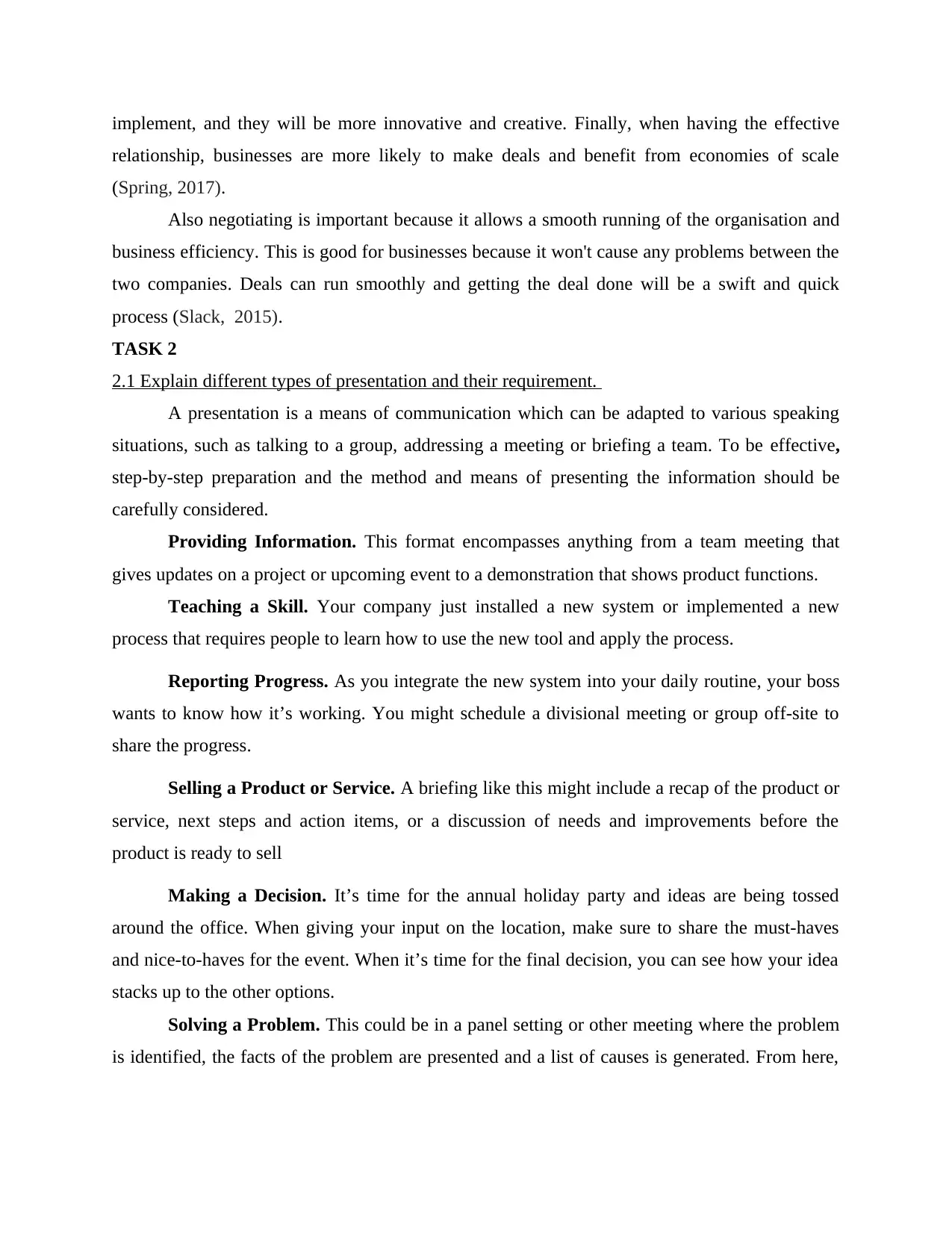
implement, and they will be more innovative and creative. Finally, when having the effective
relationship, businesses are more likely to make deals and benefit from economies of scale
(Spring, 2017).
Also negotiating is important because it allows a smooth running of the organisation and
business efficiency. This is good for businesses because it won't cause any problems between the
two companies. Deals can run smoothly and getting the deal done will be a swift and quick
process (Slack, 2015).
TASK 2
2.1 Explain different types of presentation and their requirement.
A presentation is a means of communication which can be adapted to various speaking
situations, such as talking to a group, addressing a meeting or briefing a team. To be effective,
step-by-step preparation and the method and means of presenting the information should be
carefully considered.
Providing Information. This format encompasses anything from a team meeting that
gives updates on a project or upcoming event to a demonstration that shows product functions.
Teaching a Skill. Your company just installed a new system or implemented a new
process that requires people to learn how to use the new tool and apply the process.
Reporting Progress. As you integrate the new system into your daily routine, your boss
wants to know how it’s working. You might schedule a divisional meeting or group off-site to
share the progress.
Selling a Product or Service. A briefing like this might include a recap of the product or
service, next steps and action items, or a discussion of needs and improvements before the
product is ready to sell
Making a Decision. It’s time for the annual holiday party and ideas are being tossed
around the office. When giving your input on the location, make sure to share the must-haves
and nice-to-haves for the event. When it’s time for the final decision, you can see how your idea
stacks up to the other options.
Solving a Problem. This could be in a panel setting or other meeting where the problem
is identified, the facts of the problem are presented and a list of causes is generated. From here,
relationship, businesses are more likely to make deals and benefit from economies of scale
(Spring, 2017).
Also negotiating is important because it allows a smooth running of the organisation and
business efficiency. This is good for businesses because it won't cause any problems between the
two companies. Deals can run smoothly and getting the deal done will be a swift and quick
process (Slack, 2015).
TASK 2
2.1 Explain different types of presentation and their requirement.
A presentation is a means of communication which can be adapted to various speaking
situations, such as talking to a group, addressing a meeting or briefing a team. To be effective,
step-by-step preparation and the method and means of presenting the information should be
carefully considered.
Providing Information. This format encompasses anything from a team meeting that
gives updates on a project or upcoming event to a demonstration that shows product functions.
Teaching a Skill. Your company just installed a new system or implemented a new
process that requires people to learn how to use the new tool and apply the process.
Reporting Progress. As you integrate the new system into your daily routine, your boss
wants to know how it’s working. You might schedule a divisional meeting or group off-site to
share the progress.
Selling a Product or Service. A briefing like this might include a recap of the product or
service, next steps and action items, or a discussion of needs and improvements before the
product is ready to sell
Making a Decision. It’s time for the annual holiday party and ideas are being tossed
around the office. When giving your input on the location, make sure to share the must-haves
and nice-to-haves for the event. When it’s time for the final decision, you can see how your idea
stacks up to the other options.
Solving a Problem. This could be in a panel setting or other meeting where the problem
is identified, the facts of the problem are presented and a list of causes is generated. From here,
Paraphrase This Document
Need a fresh take? Get an instant paraphrase of this document with our AI Paraphraser
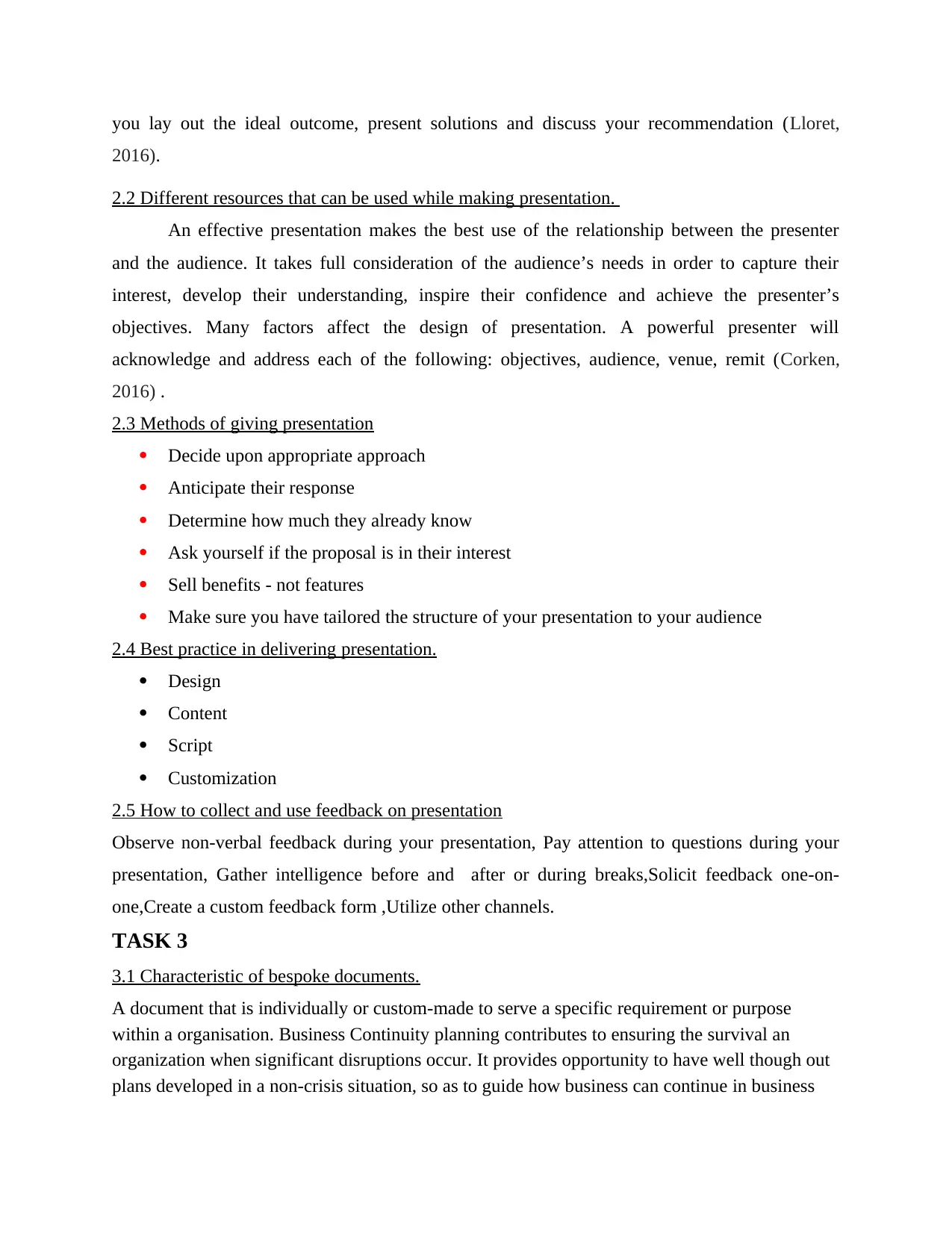
you lay out the ideal outcome, present solutions and discuss your recommendation (Lloret,
2016).
2.2 Different resources that can be used while making presentation.
An effective presentation makes the best use of the relationship between the presenter
and the audience. It takes full consideration of the audience’s needs in order to capture their
interest, develop their understanding, inspire their confidence and achieve the presenter’s
objectives. Many factors affect the design of presentation. A powerful presenter will
acknowledge and address each of the following: objectives, audience, venue, remit (Corken,
2016) .
2.3 Methods of giving presentation
Decide upon appropriate approach
Anticipate their response
Determine how much they already know
Ask yourself if the proposal is in their interest
Sell benefits - not features
Make sure you have tailored the structure of your presentation to your audience
2.4 Best practice in delivering presentation.
Design
Content
Script
Customization
2.5 How to collect and use feedback on presentation
Observe non-verbal feedback during your presentation, Pay attention to questions during your
presentation, Gather intelligence before and after or during breaks,Solicit feedback one-on-
one,Create a custom feedback form ,Utilize other channels.
TASK 3
3.1 Characteristic of bespoke documents.
A document that is individually or custom-made to serve a specific requirement or purpose
within a organisation. Business Continuity planning contributes to ensuring the survival an
organization when significant disruptions occur. It provides opportunity to have well though out
plans developed in a non-crisis situation, so as to guide how business can continue in business
2016).
2.2 Different resources that can be used while making presentation.
An effective presentation makes the best use of the relationship between the presenter
and the audience. It takes full consideration of the audience’s needs in order to capture their
interest, develop their understanding, inspire their confidence and achieve the presenter’s
objectives. Many factors affect the design of presentation. A powerful presenter will
acknowledge and address each of the following: objectives, audience, venue, remit (Corken,
2016) .
2.3 Methods of giving presentation
Decide upon appropriate approach
Anticipate their response
Determine how much they already know
Ask yourself if the proposal is in their interest
Sell benefits - not features
Make sure you have tailored the structure of your presentation to your audience
2.4 Best practice in delivering presentation.
Design
Content
Script
Customization
2.5 How to collect and use feedback on presentation
Observe non-verbal feedback during your presentation, Pay attention to questions during your
presentation, Gather intelligence before and after or during breaks,Solicit feedback one-on-
one,Create a custom feedback form ,Utilize other channels.
TASK 3
3.1 Characteristic of bespoke documents.
A document that is individually or custom-made to serve a specific requirement or purpose
within a organisation. Business Continuity planning contributes to ensuring the survival an
organization when significant disruptions occur. It provides opportunity to have well though out
plans developed in a non-crisis situation, so as to guide how business can continue in business
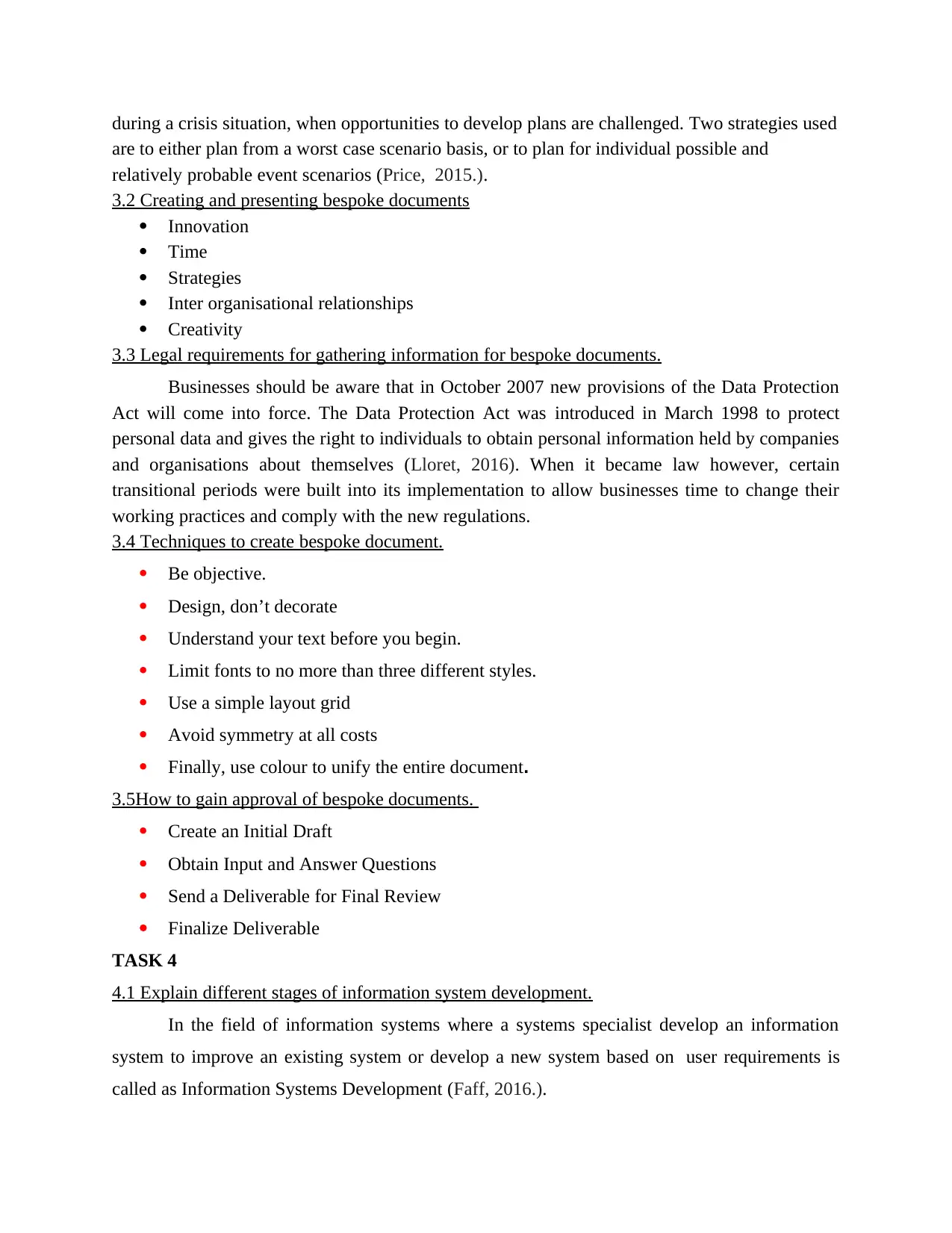
during a crisis situation, when opportunities to develop plans are challenged. Two strategies used
are to either plan from a worst case scenario basis, or to plan for individual possible and
relatively probable event scenarios (Price, 2015.).
3.2 Creating and presenting bespoke documents
Innovation
Time
Strategies
Inter organisational relationships
Creativity
3.3 Legal requirements for gathering information for bespoke documents.
Businesses should be aware that in October 2007 new provisions of the Data Protection
Act will come into force. The Data Protection Act was introduced in March 1998 to protect
personal data and gives the right to individuals to obtain personal information held by companies
and organisations about themselves (Lloret, 2016). When it became law however, certain
transitional periods were built into its implementation to allow businesses time to change their
working practices and comply with the new regulations.
3.4 Techniques to create bespoke document.
Be objective.
Design, don’t decorate
Understand your text before you begin.
Limit fonts to no more than three different styles.
Use a simple layout grid
Avoid symmetry at all costs
Finally, use colour to unify the entire document.
3.5How to gain approval of bespoke documents.
Create an Initial Draft
Obtain Input and Answer Questions
Send a Deliverable for Final Review
Finalize Deliverable
TASK 4
4.1 Explain different stages of information system development.
In the field of information systems where a systems specialist develop an information
system to improve an existing system or develop a new system based on user requirements is
called as Information Systems Development (Faff, 2016.).
are to either plan from a worst case scenario basis, or to plan for individual possible and
relatively probable event scenarios (Price, 2015.).
3.2 Creating and presenting bespoke documents
Innovation
Time
Strategies
Inter organisational relationships
Creativity
3.3 Legal requirements for gathering information for bespoke documents.
Businesses should be aware that in October 2007 new provisions of the Data Protection
Act will come into force. The Data Protection Act was introduced in March 1998 to protect
personal data and gives the right to individuals to obtain personal information held by companies
and organisations about themselves (Lloret, 2016). When it became law however, certain
transitional periods were built into its implementation to allow businesses time to change their
working practices and comply with the new regulations.
3.4 Techniques to create bespoke document.
Be objective.
Design, don’t decorate
Understand your text before you begin.
Limit fonts to no more than three different styles.
Use a simple layout grid
Avoid symmetry at all costs
Finally, use colour to unify the entire document.
3.5How to gain approval of bespoke documents.
Create an Initial Draft
Obtain Input and Answer Questions
Send a Deliverable for Final Review
Finalize Deliverable
TASK 4
4.1 Explain different stages of information system development.
In the field of information systems where a systems specialist develop an information
system to improve an existing system or develop a new system based on user requirements is
called as Information Systems Development (Faff, 2016.).
⊘ This is a preview!⊘
Do you want full access?
Subscribe today to unlock all pages.

Trusted by 1+ million students worldwide
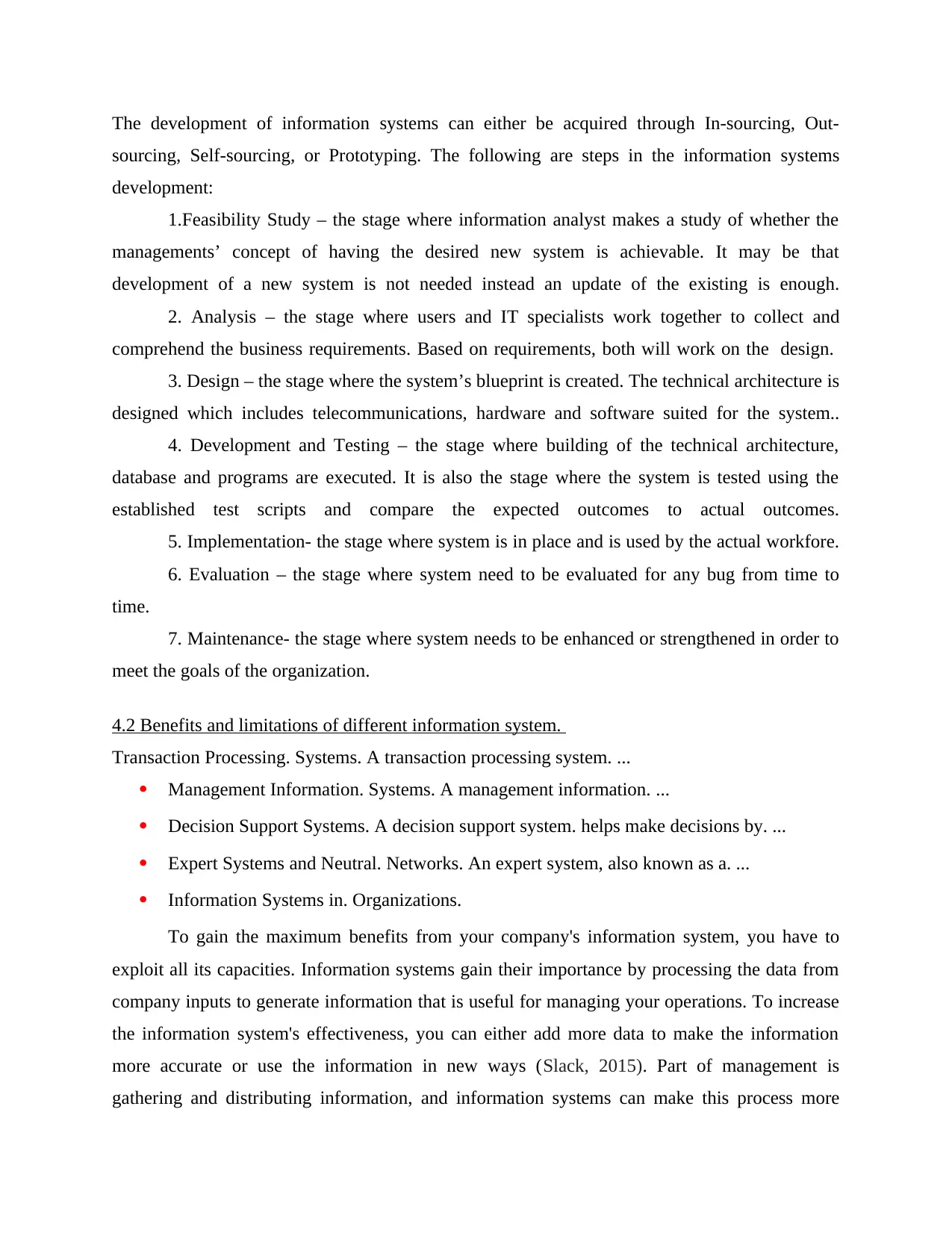
The development of information systems can either be acquired through In-sourcing, Out-
sourcing, Self-sourcing, or Prototyping. The following are steps in the information systems
development:
1.Feasibility Study – the stage where information analyst makes a study of whether the
managements’ concept of having the desired new system is achievable. It may be that
development of a new system is not needed instead an update of the existing is enough.
2. Analysis – the stage where users and IT specialists work together to collect and
comprehend the business requirements. Based on requirements, both will work on the design.
3. Design – the stage where the system’s blueprint is created. The technical architecture is
designed which includes telecommunications, hardware and software suited for the system..
4. Development and Testing – the stage where building of the technical architecture,
database and programs are executed. It is also the stage where the system is tested using the
established test scripts and compare the expected outcomes to actual outcomes.
5. Implementation- the stage where system is in place and is used by the actual workfore.
6. Evaluation – the stage where system need to be evaluated for any bug from time to
time.
7. Maintenance- the stage where system needs to be enhanced or strengthened in order to
meet the goals of the organization.
4.2 Benefits and limitations of different information system.
Transaction Processing. Systems. A transaction processing system. ...
Management Information. Systems. A management information. ...
Decision Support Systems. A decision support system. helps make decisions by. ...
Expert Systems and Neutral. Networks. An expert system, also known as a. ...
Information Systems in. Organizations.
To gain the maximum benefits from your company's information system, you have to
exploit all its capacities. Information systems gain their importance by processing the data from
company inputs to generate information that is useful for managing your operations. To increase
the information system's effectiveness, you can either add more data to make the information
more accurate or use the information in new ways (Slack, 2015). Part of management is
gathering and distributing information, and information systems can make this process more
sourcing, Self-sourcing, or Prototyping. The following are steps in the information systems
development:
1.Feasibility Study – the stage where information analyst makes a study of whether the
managements’ concept of having the desired new system is achievable. It may be that
development of a new system is not needed instead an update of the existing is enough.
2. Analysis – the stage where users and IT specialists work together to collect and
comprehend the business requirements. Based on requirements, both will work on the design.
3. Design – the stage where the system’s blueprint is created. The technical architecture is
designed which includes telecommunications, hardware and software suited for the system..
4. Development and Testing – the stage where building of the technical architecture,
database and programs are executed. It is also the stage where the system is tested using the
established test scripts and compare the expected outcomes to actual outcomes.
5. Implementation- the stage where system is in place and is used by the actual workfore.
6. Evaluation – the stage where system need to be evaluated for any bug from time to
time.
7. Maintenance- the stage where system needs to be enhanced or strengthened in order to
meet the goals of the organization.
4.2 Benefits and limitations of different information system.
Transaction Processing. Systems. A transaction processing system. ...
Management Information. Systems. A management information. ...
Decision Support Systems. A decision support system. helps make decisions by. ...
Expert Systems and Neutral. Networks. An expert system, also known as a. ...
Information Systems in. Organizations.
To gain the maximum benefits from your company's information system, you have to
exploit all its capacities. Information systems gain their importance by processing the data from
company inputs to generate information that is useful for managing your operations. To increase
the information system's effectiveness, you can either add more data to make the information
more accurate or use the information in new ways (Slack, 2015). Part of management is
gathering and distributing information, and information systems can make this process more
Paraphrase This Document
Need a fresh take? Get an instant paraphrase of this document with our AI Paraphraser
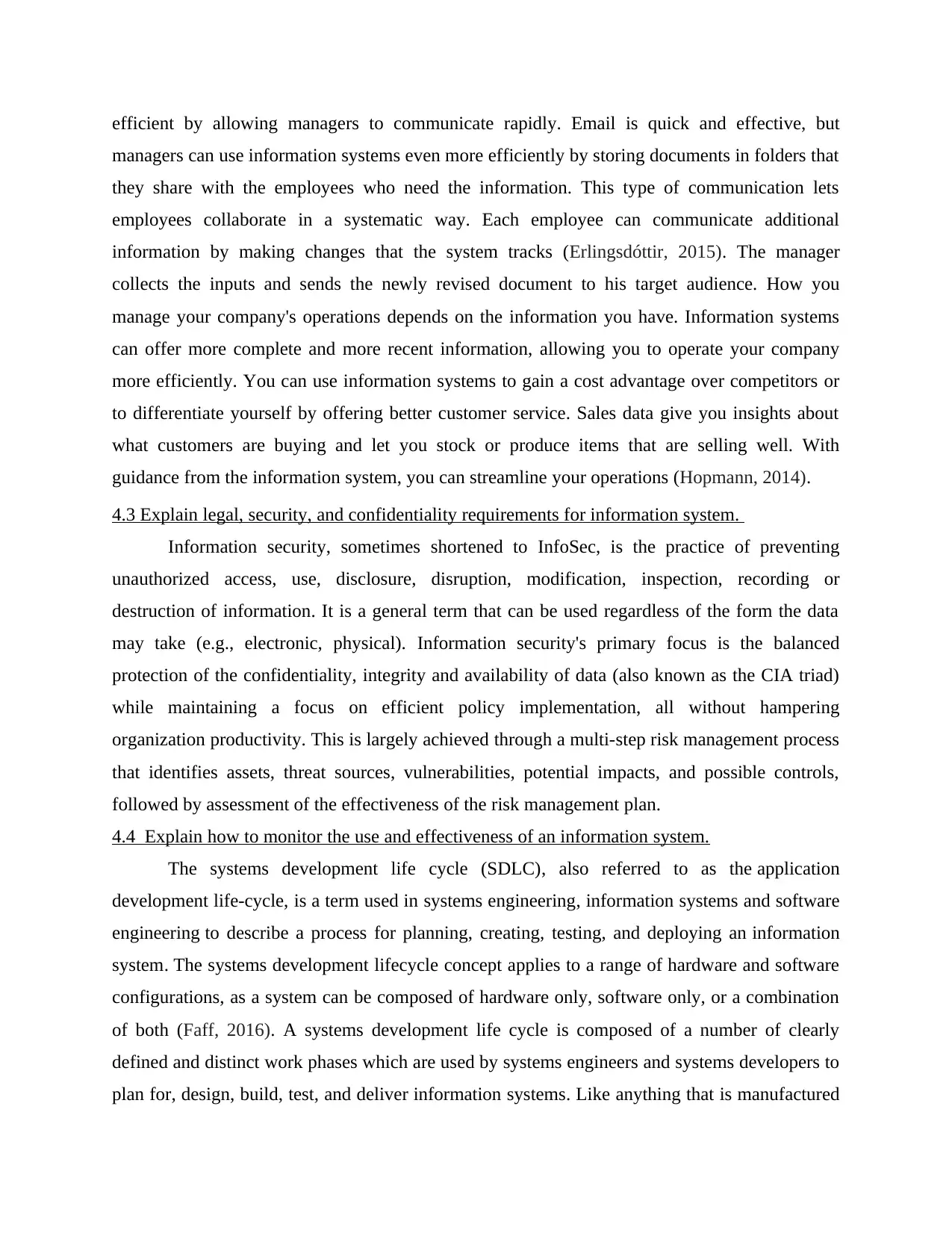
efficient by allowing managers to communicate rapidly. Email is quick and effective, but
managers can use information systems even more efficiently by storing documents in folders that
they share with the employees who need the information. This type of communication lets
employees collaborate in a systematic way. Each employee can communicate additional
information by making changes that the system tracks (Erlingsdóttir, 2015). The manager
collects the inputs and sends the newly revised document to his target audience. How you
manage your company's operations depends on the information you have. Information systems
can offer more complete and more recent information, allowing you to operate your company
more efficiently. You can use information systems to gain a cost advantage over competitors or
to differentiate yourself by offering better customer service. Sales data give you insights about
what customers are buying and let you stock or produce items that are selling well. With
guidance from the information system, you can streamline your operations (Hopmann, 2014).
4.3 Explain legal, security, and confidentiality requirements for information system.
Information security, sometimes shortened to InfoSec, is the practice of preventing
unauthorized access, use, disclosure, disruption, modification, inspection, recording or
destruction of information. It is a general term that can be used regardless of the form the data
may take (e.g., electronic, physical). Information security's primary focus is the balanced
protection of the confidentiality, integrity and availability of data (also known as the CIA triad)
while maintaining a focus on efficient policy implementation, all without hampering
organization productivity. This is largely achieved through a multi-step risk management process
that identifies assets, threat sources, vulnerabilities, potential impacts, and possible controls,
followed by assessment of the effectiveness of the risk management plan.
4.4 Explain how to monitor the use and effectiveness of an information system.
The systems development life cycle (SDLC), also referred to as the application
development life-cycle, is a term used in systems engineering, information systems and software
engineering to describe a process for planning, creating, testing, and deploying an information
system. The systems development lifecycle concept applies to a range of hardware and software
configurations, as a system can be composed of hardware only, software only, or a combination
of both (Faff, 2016). A systems development life cycle is composed of a number of clearly
defined and distinct work phases which are used by systems engineers and systems developers to
plan for, design, build, test, and deliver information systems. Like anything that is manufactured
managers can use information systems even more efficiently by storing documents in folders that
they share with the employees who need the information. This type of communication lets
employees collaborate in a systematic way. Each employee can communicate additional
information by making changes that the system tracks (Erlingsdóttir, 2015). The manager
collects the inputs and sends the newly revised document to his target audience. How you
manage your company's operations depends on the information you have. Information systems
can offer more complete and more recent information, allowing you to operate your company
more efficiently. You can use information systems to gain a cost advantage over competitors or
to differentiate yourself by offering better customer service. Sales data give you insights about
what customers are buying and let you stock or produce items that are selling well. With
guidance from the information system, you can streamline your operations (Hopmann, 2014).
4.3 Explain legal, security, and confidentiality requirements for information system.
Information security, sometimes shortened to InfoSec, is the practice of preventing
unauthorized access, use, disclosure, disruption, modification, inspection, recording or
destruction of information. It is a general term that can be used regardless of the form the data
may take (e.g., electronic, physical). Information security's primary focus is the balanced
protection of the confidentiality, integrity and availability of data (also known as the CIA triad)
while maintaining a focus on efficient policy implementation, all without hampering
organization productivity. This is largely achieved through a multi-step risk management process
that identifies assets, threat sources, vulnerabilities, potential impacts, and possible controls,
followed by assessment of the effectiveness of the risk management plan.
4.4 Explain how to monitor the use and effectiveness of an information system.
The systems development life cycle (SDLC), also referred to as the application
development life-cycle, is a term used in systems engineering, information systems and software
engineering to describe a process for planning, creating, testing, and deploying an information
system. The systems development lifecycle concept applies to a range of hardware and software
configurations, as a system can be composed of hardware only, software only, or a combination
of both (Faff, 2016). A systems development life cycle is composed of a number of clearly
defined and distinct work phases which are used by systems engineers and systems developers to
plan for, design, build, test, and deliver information systems. Like anything that is manufactured

on an assembly line, an SDLC aims to produce high-quality systems that meet or exceed
customer expectations, based on customer requirements, by delivering systems which move
through each clearly defined phase, within scheduled time frames and cost estimates.Computer
systems are complex and often (especially with the recent rise of service-oriented architecture)
link multiple traditional systems potentially supplied by different software vendors. To manage
this level of complexity, a number of SDLC models or methodologies have been created, such
aswaterfall,spiral,Agile software development,rapid prototyping,incremental, and synchronize
and stabilize (Price, 2015).
CONCLUSION
Business communication is vital in business success. For communication to be effective
it should embrace good relationships with major stakeholders of a business. Communication
means more than just giving out messages; it involves speaking, listening, sending and receiving
messages.
REFERENCES
Books and Journals
Corken, R., 2016. Good negotiation and land-use planning: the status of negotiation in the NSW
planning profession. Australian Planner. 53(3). pp.201-210.
Della, Corte., 2016. Coopetition and sustainable competitive advantage. The case of tourist
destinations. Tourism Management. 54. pp.524-540.
customer expectations, based on customer requirements, by delivering systems which move
through each clearly defined phase, within scheduled time frames and cost estimates.Computer
systems are complex and often (especially with the recent rise of service-oriented architecture)
link multiple traditional systems potentially supplied by different software vendors. To manage
this level of complexity, a number of SDLC models or methodologies have been created, such
aswaterfall,spiral,Agile software development,rapid prototyping,incremental, and synchronize
and stabilize (Price, 2015).
CONCLUSION
Business communication is vital in business success. For communication to be effective
it should embrace good relationships with major stakeholders of a business. Communication
means more than just giving out messages; it involves speaking, listening, sending and receiving
messages.
REFERENCES
Books and Journals
Corken, R., 2016. Good negotiation and land-use planning: the status of negotiation in the NSW
planning profession. Australian Planner. 53(3). pp.201-210.
Della, Corte., 2016. Coopetition and sustainable competitive advantage. The case of tourist
destinations. Tourism Management. 54. pp.524-540.
⊘ This is a preview!⊘
Do you want full access?
Subscribe today to unlock all pages.

Trusted by 1+ million students worldwide
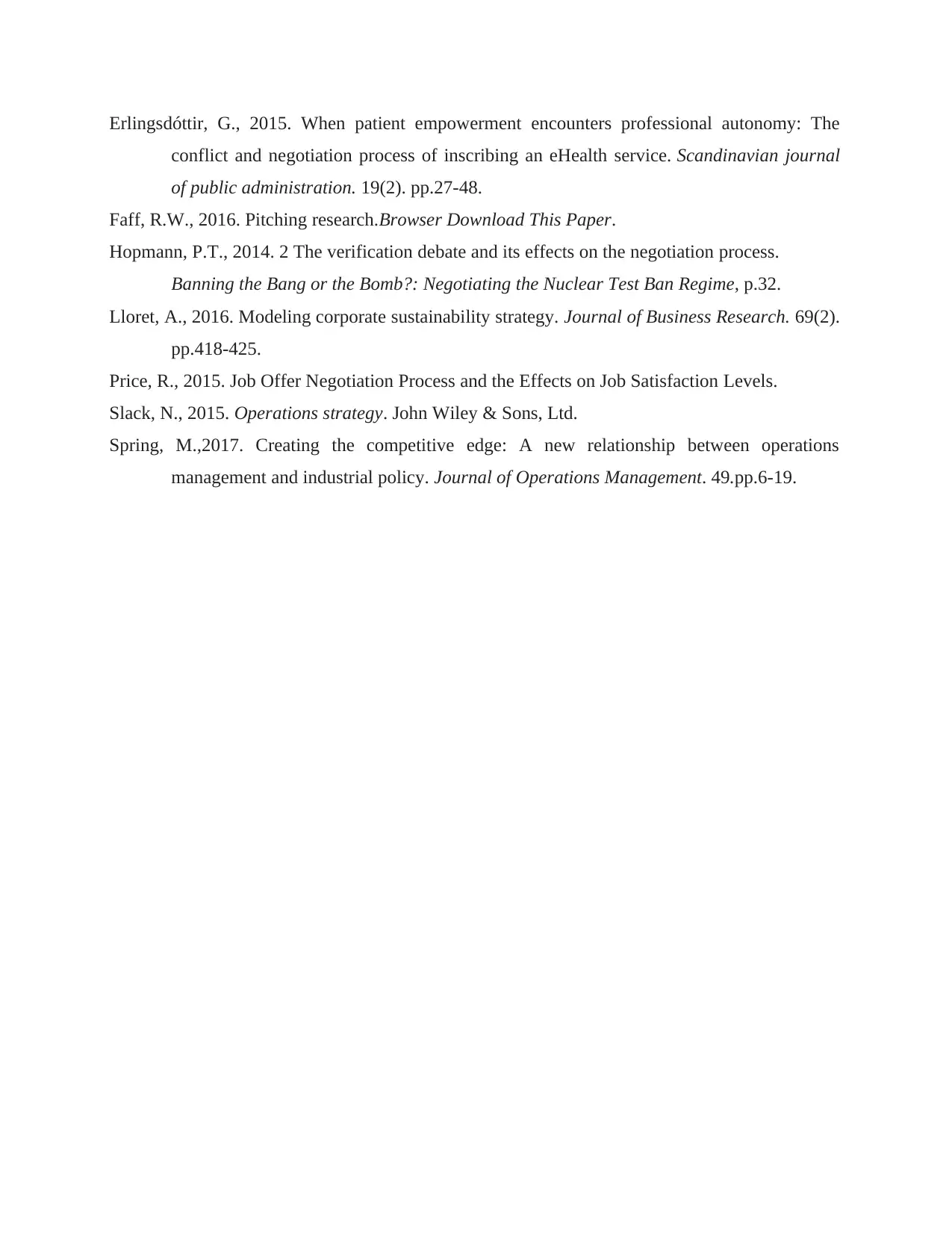
Erlingsdóttir, G., 2015. When patient empowerment encounters professional autonomy: The
conflict and negotiation process of inscribing an eHealth service. Scandinavian journal
of public administration. 19(2). pp.27-48.
Faff, R.W., 2016. Pitching research.Browser Download This Paper.
Hopmann, P.T., 2014. 2 The verification debate and its effects on the negotiation process.
Banning the Bang or the Bomb?: Negotiating the Nuclear Test Ban Regime, p.32.
Lloret, A., 2016. Modeling corporate sustainability strategy. Journal of Business Research. 69(2).
pp.418-425.
Price, R., 2015. Job Offer Negotiation Process and the Effects on Job Satisfaction Levels.
Slack, N., 2015. Operations strategy. John Wiley & Sons, Ltd.
Spring, M.,2017. Creating the competitive edge: A new relationship between operations
management and industrial policy. Journal of Operations Management. 49.pp.6-19.
conflict and negotiation process of inscribing an eHealth service. Scandinavian journal
of public administration. 19(2). pp.27-48.
Faff, R.W., 2016. Pitching research.Browser Download This Paper.
Hopmann, P.T., 2014. 2 The verification debate and its effects on the negotiation process.
Banning the Bang or the Bomb?: Negotiating the Nuclear Test Ban Regime, p.32.
Lloret, A., 2016. Modeling corporate sustainability strategy. Journal of Business Research. 69(2).
pp.418-425.
Price, R., 2015. Job Offer Negotiation Process and the Effects on Job Satisfaction Levels.
Slack, N., 2015. Operations strategy. John Wiley & Sons, Ltd.
Spring, M.,2017. Creating the competitive edge: A new relationship between operations
management and industrial policy. Journal of Operations Management. 49.pp.6-19.
1 out of 10